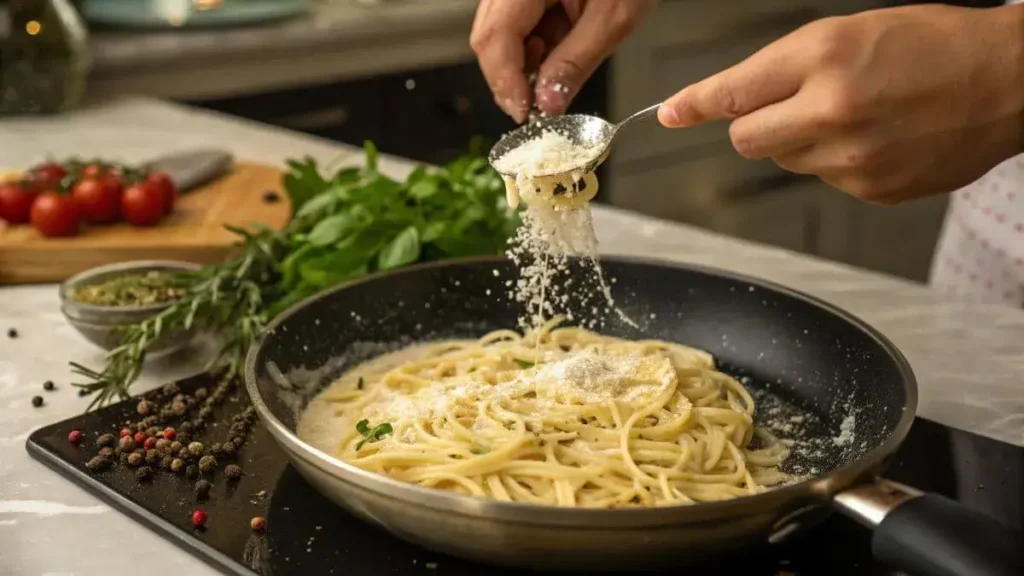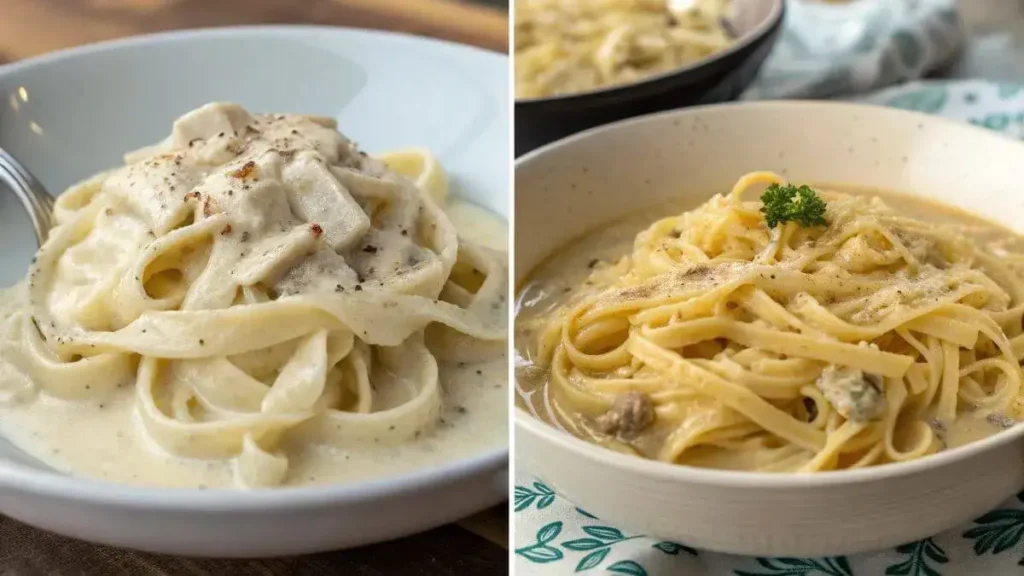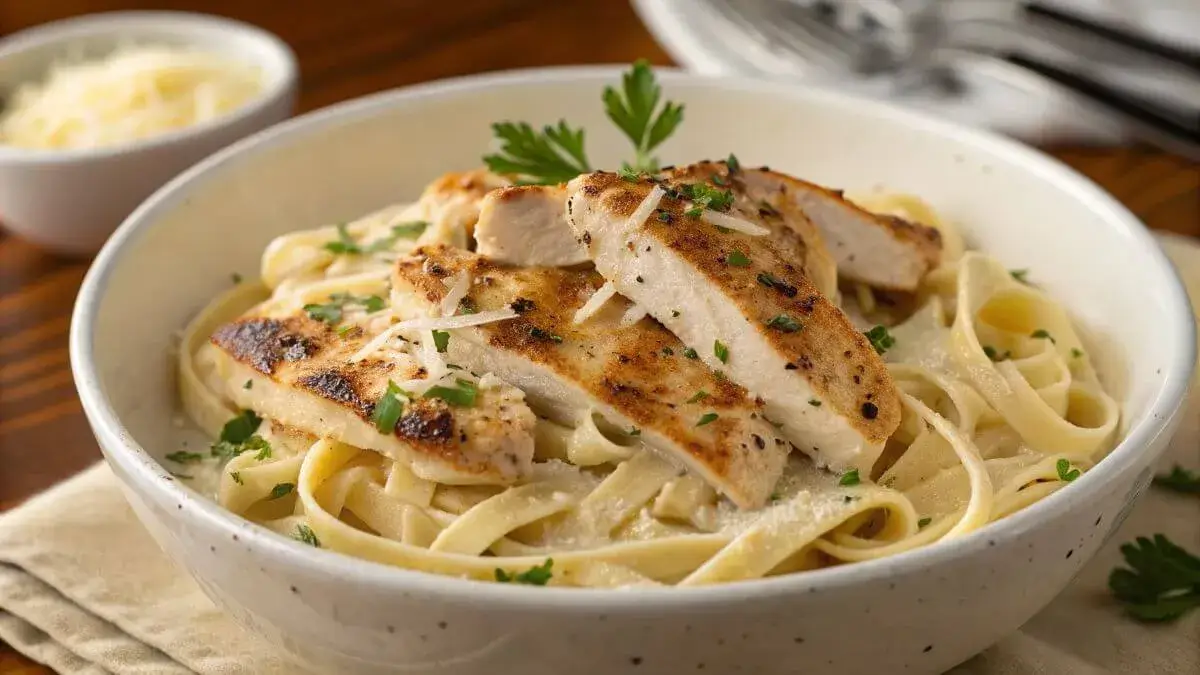Craving a creamy, indulgent bowl of chicken alfredo but unsure which pasta to use? You’re not alone! The right pasta can elevate this classic dish from good to unforgettable, while the wrong choice might leave you with a soggy mess. This article dives into pairing pasta shapes with rich, velvety sauces like alfredo, answering the question: What pasta is best for chicken alfredo? We’ll explore texture, sauce adherence, and cooking hacks to ensure your next meal is a hit. Let’s dig in!
The Heart of the Dish – Why Pasta Choice Matters
The Role of Pasta in Chicken Alfredo
Think of pasta as the unsung hero of your chicken alfredo. It’s not just a vehicle for the sauce—it’s a critical component that affects every bite. Cream-based sauces like alfredo demand pasta that can hold its own without getting lost in the richness. For instance, flat, broad noodles trap sauce beautifully, while hollow shapes might let it slide right off. So, when asking what pasta is best for chicken alfredo, consider how the shape interacts with the sauce’s weight and texture.
Key Factors to Consider When Choosing Pasta
- Shape and Surface Area: Ribbon-like pasta (think fettuccine or pappardelle) has broad surfaces that cling to creamy sauces. Meanwhile, tubular options like rigatoni offer nooks for the sauce to nestle into.
- Sauce Adherence: Have you ever noticed how some pasta leaves sauce pooled at the bottom of the bowl? To avoid this, pick shapes with ridges or curves that grip the sauce instead of shedding it.
- Texture and Bite: Al dente pasta is non-negotiable here. Overcooked noodles turn mushy under heavy sauces, so aim for a firm texture that stands up to the cream.
- Cooking Time: Thicker pasta takes longer to cook, which can be tricky if you multitask. Stick to options that align with your schedule—linguine cooks faster than tagliatelle.
By now, you’re probably thinking, “But what pasta is best for chicken alfredo?” Don’t worry—we’ll get to specific recommendations in the following sections. For now, remember: the goal is balance. Your pasta should complement the sauce, not compete with it!
The Best Pasta Shapes for Chicken Alfredo
Fettuccine – The Timeless Winner
Let’s start with the obvious: fettuccine is the MVP of chicken alfredo. Its flat, wide shape acts like a flavor magnet, clinging to every ounce of that creamy sauce. When pondering what pasta is best for chicken alfredo, this is the answer you’ll see in nearly every Italian restaurant—and for good reason. The noodle’s thickness balances the richness of the sauce without turning mushy.
But here’s a pro tip: If using dried fettuccine, cook it al dente (firm to the bite) to avoid sogginess. On the other hand, fresh fettuccine cooks in just 2–3 minutes and adds a luxurious silkiness to the dish. Either way, you can’t go wrong with this classic pairing!
Surprising Contenders – Beyond the Basics
Not everyone wants to stick to tradition—and that’s okay! For a fun twist, try cavatappi (corkscrew pasta) or rigatoni. Their ridges and hollow centers trap sauce like tiny edible buckets, ensuring each bite bursts with flavor. Even linguine, a thinner cousin of fettuccine, works wonders if you crave something lighter.
And hey, if you’re feeling adventurous, pappardelle—a broad, ribbon-like pasta—adds a rustic touch. The key here is to match the pasta’s texture and surface area to the sauce’s weight. So, when asking what pasta is best for chicken alfredo, remember: it’s all about what makes your taste buds dance!
Common Pitfalls When Choosing Pasta
Overlooking Pasta Texture
Here’s the deal: Texture matters. A limp noodle drowned in alfredo sauce is a culinary crime. Always aim for al dente pasta, which holds its shape under the sauce’s weight. To nail this, taste-test your pasta 1–2 minutes before the package’s suggested cooking time. And don’t forget—salting the boiling water is non-negotiable. Bland pasta ruins even the creamiest alfredo!
Another mistake? Use delicate pasta like angel hair or capellini. These thin noodles turn soggy fast and can’t stand up to a heavy sauce. Stick to sturdier shapes unless you want a plate of mush.
Forgetting the Sauce-to-Pasta Bond
Ever served a dish where the sauce pools at the bottom? Yikes. Toss your cooked pasta directly in the sauce over low heat to avoid this. This helps the noodles absorb the flavors and creates a seamless bond. Pro tip: Save a splash of starchy pasta water to adjust the sauce’s consistency—it’s a game-changer!
And here’s a final thought: While debating what pasta is best for chicken alfredo, don’t overlook portion sizes. Too much pasta dilutes the sauce, leaving you with a bland meal. Stick to a 1:1 sauce ratio to pasta for that perfect, velvety bite.
Pro Tips for Perfect Chicken Alfredo Every Time
Hack the Cooking Process

First things first: Don’t rinse your pasta after draining. That starchy coating is a flavor glue that helps the sauce cling to every noodle. But here’s the kicker: Toss the pasta in the sauce immediately after cooking. This lets the heat from the noodles thicken the sauce naturally.
Meanwhile, if your alfredo feels too thick, add a splash of starchy pasta water—a little goes a long way. And don’t forget to season in layers! Salt the pasta water, sauce, and chicken separately to build depth.
Ingredient Swaps for Dietary Needs
Do you have dietary restrictions? No sweat! Swap regular pasta for gluten-free fettuccine or zucchini noodles (zoodles) for a low-carb twist. Blend cashews with nutritional yeast for a dairy-free version to mimic that creamy texture.
But let’s reevaluate what pasta is best for chicken alfredo if you’re avoiding gluten. Rice-based pasta holds up surprisingly well, but cook it al dente to prevent mushiness. Need inspiration? Check out our Creamy Garlic Parmesan Chicken recipe for a sauce technique that pairs perfectly with alternative pastas.
Final Thoughts – Balancing Flavor and Practicality
Pairing Pasta with Sides and Wine
So, you’ve nailed the pasta choice—now what? Keep sides simple. A crisp Caesar salad or roasted veggies cut through the dish’s richness. For wine, opt for a buttery Chardonnay or a light Pinot Grigio.
And here’s a sneaky trick: Reserve a handful of grated Parmesan to sprinkle on top just before serving. It adds a salty crunch that elevates the entire meal.
The Last Word on What Pasta Is Best for Chicken Alfredo
In short, fettuccine reigns supreme for its sauce-trapping superpowers, but don’t shy away from experimenting with shapes like rigatoni or pappardelle. The key is balancing texture, sauce adherence, and personal preference.
For more cozy comfort food ideas, explore our One-Pot Garlic Parmesan Pasta recipe—a crowd-pleaser complements this guide perfectly. Now, go forth and cook with confidence!
Leftover Magic – Reinventing Chicken Alfredo
How to Revive Leftover Pasta
Let’s face it: leftover chicken alfredo can turn into a gloopy mess if stored wrong. But don’t toss it just yet! First off, always store pasta and sauce separately. This keeps the noodles from soaking up too much liquid overnight. When reheating, add a splash of milk or broth to loosen the sauce, then warm it gently on the stove.
But here’s a twist: Transform leftovers into a baked casserole. Mix the pasta with extra cheese, breadcrumbs, and veggies, then bake until golden. It’s a crispy, crowd-pleasing upgrade that answers what pasta is best for chicken alfredo leftovers—sturdy shapes like penne or rigatoni hold up best in the oven!
Meal Prep Like a Pro
Planning? Cook pasta al dente and freeze it in portion-sized bags. When ready to eat, drop frozen noodles into boiling water for 1–2 minutes. Pair with freshly made sauce for a meal that tastes just made.
And here’s a pro tip: Freeze sauce in ice cube trays for single-serving convenience. Need more meal prep ideas? Try our Easy Freezer-Friendly Chicken Recipes to save time without skimping on flavor.
Expert Q&A – Your Burning Questions Answered
“Can I Use Gluten-Free Pasta?”
Absolutely! Gluten-free fettuccine or brown rice pasta works tremendously, but stick to shorter cooking times to avoid mush. Always toss gluten-free pasta with sauce immediately after draining—it dries out faster than regular noodles.
And here’s a hack: Add a teaspoon of olive oil to the boiling water to prevent sticking. When debating what pasta is best for chicken alfredo for gluten-free diets, prioritize brands with xanthan gum for better texture.
“Can I Freeze Chicken Alfredo?”
You bet—but with caveats. Freeze sauce only (without pasta) in airtight containers for up to 3 months. Thaw it overnight in the fridge, then reheat gently while cooking fresh pasta. Avoid freezing creamy sauces with cheese-heavy bases, as they can separate.
But wait—there’s more! For a freezer-friendly twist, try using heartier sauces like marinara. Craving more freezer tips? Our Make-Ahead Freezer Meals Guide has you covered.
Elevating Your Chicken Alfredo Experience
Garnishes and Toppings That Shine
Once you’ve nailed what pasta is best for chicken alfredo, it’s time to dress it up! Fresh herbs like parsley or basil add color and brightness, while a sprinkle of red pepper flakes introduces a subtle kick. Try toasted pine nuts or crispy garlic chips for crunch—they contrast beautifully with the creamy sauce.
But here’s the catch: Less is more. Overloading with toppings can drown out the dish’s star—the pasta. Stick to one or two additions that highlight, rather than hide, your carefully chosen noodles. For example, a light grating of Parmesan lets the fettuccine or rigatoni shine while adding salty depth.
Plating Like a Pro

Presentation matters! Use wide, shallow bowls to showcase the pasta’s shape and sauce cling. Twirl fettuccine into nests with tongs for height or layer rigatoni to highlight its ridges. Drizzle extra sauce over the top and place grilled chicken slices artfully on the side. Finish with a crack of black pepper or a herb sprig for Instagram-worthy flair.
Pro tip: Warm your bowls before serving. This keeps the dish hot longer and prevents the sauce from seizing up. After all, what pasta is best for chicken Alfredo? It loses its charm if it’s cold and clumpy!
The Final Takeaway – Mastering Chicken Alfredo
Key Lessons Recap
Let’s reevaluate: What pasta is best for chicken alfredo? The answer hinges on texture, sauce grip, and personal taste. Fettuccine reigns supreme for its classic pairing, but pappardelle or cavatappi offer fun twists. Always cook noodles al dente, toss them hot with the sauce, and balance richness with fresh garnishes.
Another takeaway? Quality ingredients matter. Splurge on fresh Parmesan and real cream—they elevate the dish from “meh” to magnificent. And don’t forget: Salting pasta water is non-negotiable for flavor-packed noodles!
Embrace Your Inner Chef
Now that you’re armed with knowledge, experiment fearlessly. Swap chicken for shrimp, add roasted mushrooms, or mix spinach for a veggie boost. Try blending a splash of white wine into the sauce for complexity.
Cooking is an adventure, and Chicken Alfredo is your canvas. So grab that wooden spoon, choose your pasta wisely, and create a dish that’s uniquely yours. Bon appétit!


3 thoughts on “What Pasta Is Best for Chicken Alfredo?”